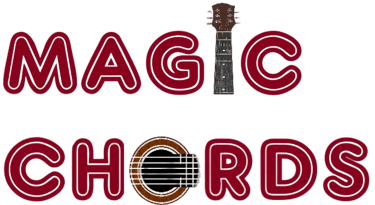
How to Improve Your Guitar Rhythm and Timing Like a Pro
Master your guitar rhythm and play with precision. Discover techniques, timing tips and rhythm exercises to enhance your groove, timing and overall performance!
magicchords.com
10/20/2025


Mastering guitar rhythm is the key to sounding like a pro. Learn how to improve your timing, groove, and consistency with practical exercises and expert rhythm-building tips.
Developing a solid sense of Guitar Rhythm is one of the most important skills every guitarist must master to sound confident, natural, and in control. Whether you’re playing simple chords or complex solos, strong rhythm is the foundation that keeps your music tight and expressive. Many beginners focus solely on learning notes and chords, but without timing and groove, even the most perfect progression can sound unsteady.
Understanding guitar rhythm helps you connect every strum, pluck, and beat into a cohesive flow that brings your music to life. To improve your guitar rhythm, start with slow, consistent practice. Use a metronome or backing track to internalize the beat, gradually increasing your speed as accuracy improves. Experiment with different strumming patterns, syncopated rhythms, and percussive techniques to build variety and texture in your playing. Listening to rhythm-driven genres such as blues, funk, and rock can also help train your ear to recognize timing nuances and groove.


Another essential step is learning to play with others — whether with a band or along with recordings. This interaction strengthens your rhythmic awareness and helps you adapt to varying tempos and styles. Remember, mastering guitar rhythm isn’t about speed; it’s about consistency, feel, and timing. With focused practice, patience, and musical curiosity, you can transform your playing from mechanical to dynamic, giving every song you play a professional touch and irresistible groove.
Guitar tips for beginners 1: When learning to play guitar, it’s important to balance technique and timing. Many beginners focus only on chords, forgetting that smooth transitions and consistent tempo define great playing. Practicing the G7 chord is an excellent way to improve coordination while also developing a sense of guitar rhythm. Start by strumming slowly and counting beats out loud, ensuring each note rings clearly. Over time, your strumming will feel natural, your timing tighter, and your overall sound far more polished and professional.


Understanding Guitar Rhythm: The Foundation of Music
Guitar rhythm serves as the cornerstone of music, intricately woven into every piece, regardless of genre. It encompasses the timing and duration of notes played on the guitar, shaping how musicians interpret and perform a composition. Without a solid grasp of rhythm, even the most skillful guitarists may struggle to deliver a cohesive and engaging performance. The importance of rhythm becomes evident when considering its role across various musical styles, from rock and jazz to classical and folk.
The concept of timing is central to understanding guitar rhythm. Musicians break down music into beats, measures, and tempo, each contributing to the piece's overall structure. A beat represents the basic unit of time in music, while measures group beats together, creating a repeating cycle that gives music its flow. Tempo, defined as the speed of a piece, further influences the emotional impact of a composition, guiding musicians in their expression and dynamics.
In different genres, rhythm takes on unique characteristics. For instance, rock music often emphasizes a strong backbeat, providing a driving energy, whereas jazz may incorporate syncopation and swing, allowing for fluid improvisation. In classical music, rhythm is meticulously notated, demanding precise adherence to tempo and time signatures. Regardless of style, rhythm ties individual notes and phrases together, ensuring the music resonates with listeners and evokes the intended emotions.
Ultimately, rhythm acts as the backbone of musical composition, helping to inform listeners about the song's mood and structure. Beginner guitarists must develop a keen sense of rhythm, practicing exercises that enhance timing and precision. By mastering these skills, musicians can elevate their performances, ensuring their rhythmic foundation supports and enriches their overall sound.
The Importance of Timing and Consistency
In the realm of guitar playing, the concepts of timing and consistency are paramount, serving as the backbone of musical expression. Timing refers to the precise placement of notes within a musical framework, allowing the guitarist to synchronize with other instruments or vocals. While rhythm generally encompasses the pattern of sounds and silence, timing is more focused on when each note is played, producing a cohesive and polished performance. Mastering these elements is essential for any guitarist aspiring to sound professional.
Common timing issues faced by guitarists often stem from a lack of practice with a metronome or backing tracks, which provide a structured pulse for maintaining consistent timing. Without this foundation, musicians might find themselves rushing through passages or lagging behind the beat, leading to a disjointed sound. This inconsistency can disrupt the flow of a piece, making even the most beautifully crafted solos less impactful. By integrating techniques to enhance timing and maintain consistency, players can ensure their performances resonate with clarity.
Practicing with a metronome is one effective approach to improve timing. Begin at a slow tempo, focusing intently on playing each note precisely on the beat. Gradually increase the tempo as competence enhances, fostering an intuitive sense of timing. Incorporating exercises that involve playing along with tracks can also reinforce rhythmic understanding. For instance, playing simple chords while counting beats allows the guitarist to internalize timing and experience firsthand how excellent timing elevates musicality.
Consistency in practice is crucial; set aside dedicated time to hone these skills daily. A disciplined routine not only solidifies timing but also builds overall confidence. As timing and consistency improve, the guitarist will notice a significant enhancement in their performance, resulting in a more professional sound that captivates audiences.
Essential Exercises to Improve Your Guitar Rhythm
Improving your guitar rhythm skills is crucial for any aspiring musician, as rhythm forms the backbone of musical expression. A structured approach to rhythm exercises can significantly enhance your timing and accuracy. One of the most effective methods for developing rhythm is clapping along to a metronome. By keeping time with the metronome, you can train your internal sense of timing. Start at a slow tempo, clapping along with the beat, and ensure each clap aligns perfectly with the click of the metronome. As you become more comfortable, gradually increase the tempo to challenge yourself without sacrificing accuracy.
Another practical exercise involves playing simple rhythms on your guitar. Begin by strumming basic chord progressions while focusing on consistent strumming patterns. This could include downstrokes and upstrokes in a steady sequence. Incorporate various rhythmic patterns, such as quarter notes and eighth notes, to diversify your practice. To further enhance your skills, try isolating one specific rhythm and practice it repetitively until you achieve proficiency. This method not only helps in reinforcing timing but also familiarizes you with different rhythmic feels that can be implemented in various musical contexts.
Incorporating backing tracks into your routine can also be immensely beneficial. Backing tracks provide a musical context that allows you to practice your rhythm within an ensemble setting. Choose tracks that match your skill level, and focus on how your rhythm integrates with the other instruments. Pay close attention to the timing of your chord changes and strum patterns in relation to the music. Remember the importance of starting slowly with all exercises. Gradually increase the tempo or complexity of the patterns to ensure a solid foundational understanding of rhythm. Such careful progression will ultimately lead you to sound more like a pro on the guitar.
Groove: The Secret Ingredient to Timing Mastery
In musical contexts, groove refers to the intangible feel or rhythmic quality that captures the listener's attention and propels the music forward. It is the pulse that draws musicians and audiences together, creating a sense of movement and connectivity. Groove exists within various genres of music, from the syncopated rhythms of funk to the steady backbeat of rock and the complex polyrhythms found in jazz. Understanding groove is crucial for any guitarist aiming to enhance their timing and overall musical expression.
To effectively identify groove within different genres, listen closely to the rhythmic interplay between instruments. For example, in funk music, the guitar often delivers tight, syncopated riffs that serve as a rhythmic anchor. In contrast, rock guitar might prioritize a strong downbeat, emphasizing the quarter note while allowing space for other instruments to fill in the groove. Paying attention to these nuances helps develop an awareness of how groove operates within individual styles, enabling a guitarist to adapt their timing accordingly.
Building a personal groove involves dedicated practice and exploration. Start by playing along with drum tracks or metronomes set at varying tempos; this helps internalize various rhythmic patterns. Additionally, experiment with different articulations and dynamics in your playing. Incorporating rests and varying note lengths can significantly affect the groove, making your performance more engaging. Collaborating with other musicians also enriches your sense of timing, as you’ll learn to respond to grooves in real-time. As you develop your unique groove, aim to integrate it into your playing. This will not only elevate your performances but also allow you to connect with your audience on a deeper level.
Advanced Techniques for Pro-Level Rhythm Playing
To elevate your guitar rhythm playing to a professional level, mastering advanced techniques such as syncopation, swing rhythms, and polyrhythms is essential. Each of these concepts can significantly enrich the complexity and depth of your musical compositions, providing a distinctive style that sets you apart from standard playing techniques.
Syncopation involves emphasizing beats or parts of beats that are typically unaccented. By shifting the emphasis away from the expected downbeats, you create a rhythm that surprises and engages listeners. To practice syncopation, try playing simple chord progressions while accenting off-beats. For instance, in a 4/4 time signature, focus on strumming the off-beats with your downstrokes while using upstrokes for the downbeats. Gradually incorporate syncopated patterns into your playing, allowing them to enhance your overall rhythm.
Swing rhythms introduce a relaxed feeling to your playing by extending the duration of off-beats, creating a “long-short” feel. This technique is commonly found in jazz and blues. To grasp swing, listen to swing guitarists and mimic their patterns. Practicing scales or arpeggios with a swing feel can also help internalize the rhythm. Start with a metronome set to a swing setting, or play along with swing backing tracks to develop your timing and groove.
Polyrhythms entail playing two contrasting rhythms simultaneously, which can significantly broaden your rhythmic capabilities. For example, practice playing a steady eighth-note rhythm on one guitar part while introducing triplet patterns on another. This complexity demands a solid understanding of time signatures and rhythmic subdivisions, thereby enhancing your overall musicianship.
Incorporating these advanced techniques requires patience and consistent practice. Establishing dedicated practice routines focused on syncopation, swing rhythms, and polyrhythms will ultimately yield the professional-level rhythm playing that many guitarists aspire to achieve.
Using Technology to Enhance Your Guitar Rhythm Skills
In the modern music landscape, technology has revolutionized the way musicians develop their skills, especially in mastering guitar rhythm. Various tools such as rhythm apps, digital metronomes, and backing track software are invaluable for guitarists aiming to refine their timing and rhythmical accuracy. Incorporating these technologies into practice routines can lead to significant improvements in a guitarist's overall performance.
Rhythm apps, such as "Rhythm Lab" and "BeatBuddy," offer interactive ways to practice timing while providing visual and auditory cues to enhance your rhythmic abilities. These applications often come equipped with exercises that challenge the player to maintain specific time signatures or alter rhythms. Utilizing these apps regularly can help develop a strong internal clock, essential for any proficient guitarist.
Alongside rhythm apps, digital metronomes like "Soundbrenner" or "Korg's TM-60" serve as fundamental tools for tracking tempo. By allowing you to set a variety of beats per minute (BPM) and different subdivisions, these metronomes encourage precise timing. It is advisable to start practicing at a slower tempo before gradually increasing the speed, allowing you to internalize the rhythmic patterns accurately.
Additionally, various software and online platforms provide a wide array of backing tracks tailored to different genres and styles. Programs like "iReal Pro" and websites such as "JamKazam" offer virtual jam sessions with various musical accompaniments, allowing guitarists to practice playing along with a band. These resources can immensely enhance a player's ability to stay in time while offering a real-world context for applying rhythmic skills.
In conclusion, leveraging technology such as rhythm apps, metronomes, and backing track software is essential for guitarists seeking to enhance their rhythmic skills. By integrating these tools into regular practice, guitarists can achieve a level of proficiency that mirrors professional standards. This systematic approach not only promotes better timing but also fosters a deeper understanding of rhythm in music.
Final Tips for Developing Guitar Rhythm Consistency
Developing a consistent rhythm on the guitar is an essential aspect of becoming a proficient player. It not only enhances your musical abilities but also complements your understanding of various genres. To maintain and improve your rhythm consistency, start by integrating a range of practical exercises into your daily practice routine. Consistency is key; thus, practice each exercise regularly to build muscle memory and enhance your comfort with rhythmic variations.
One effective method to start with is the use of a metronome. This indispensable tool helps you stay on beat and understand the subdivisions of different tempos. Begin at a slow pace, allowing yourself to play simple strumming patterns. Gradually increase the tempo as your confidence grows. Incorporating clapping or tapping exercises can further solidify your timing. By establishing a strong internal rhythm, you will begin to notice substantial improvements in your guitar playing.
Another beneficial approach is to learn various strumming patterns. Diversifying your musical repertoire can provide insight into different rhythms and their applications across genres. Dedicate time each week to explore new patterns, focusing on the nuances of each style. Furthermore, integrating playing along with backing tracks or recordings can enhance your consistency in real-life scenarios. It exposes you to a variety of rhythms and helps you adapt to different musical contexts.
In addition, consider joining a local music group or ensemble. Playing with other musicians will force you to maintain rhythm while adapting to others' styles. This communal aspect can not only motivate but also elevate your capabilities. Remember, patience and persistent practice are essential for mastering rhythm. With dedication, these tips and exercises will assist you in developing a robust sense of rhythm that can transform your guitar playing experience.
Guitar tips for beginners 2: Learning to play popular songs on guitar can be both motivating and educational, especially when you focus on those with simple progressions. Practicing pieces like Coldplay Yellow chords helps you develop smoother transitions and better control over your strumming hand. As you repeat these progressions, you’ll start recognizing patterns that appear in many other songs. This builds confidence and strengthens your musical ear, allowing you to experiment with rhythm, tone, and emotion while enjoying one of the most iconic tracks ever written.






